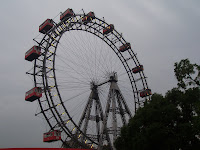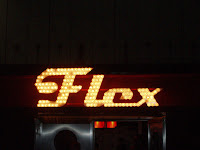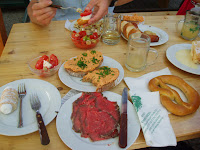More Dr. O! That’s the most advice I can give for next year’s program (other than to get rid of the Rough Guide for Prague) after today’s amazing tour of the Leopold Museum (also known as paradise). Her stories, information, and incredible knowledge of art history and actual artistic ability are astounding and worthy of additional time for students to spend with her (maybe a tour of the Belvedere?). The Leopold is a private collection – that lucky Dr. Rudolf Leopold owns all of it, but has thankfully put it on display for the rest of us. Apparently, he had a “stamp collection” of some kind, but how you can get this much art and of such unbelievable high quality seems impossible to boil down to a simple stamp collection. It features the largest collection of Schiele in the world, and thanks to this museum, I could not be more jealous of that, as he is now one of my favorite artists. There is also a great deal of Klimt, but not all of it was on display due to other exhibitions (like one on Kolo Moser, that I only had time to rush through sadly).
Dr. O gave great background information to the artists as well as analysis of major works. Klimt began as a Ringstraβe artist, showing great talent but at first showed no sign of his original vision. That changed with the Faculty series, painted for the University of Vienna, all of which were destroyed by retreating SS troops during World War II. The paintings outraged Vienna, but after acclaim elsewhere, adopted Klimt as a favorite.
We examined his “Death and Life” for a great deal of time. Dr. O told us that the painting had been finished in 1910, but added to in 1918, and we had to figure out at which point. You can find that part with the girls added on the left, which make the parts of Death and Life look like they could better fit together, and it helps deal with the empty space.
Next we turned to the Schiele room. Schiele, influenced and assisted greatly by Klimt, did something very unlike him – he painted self-portraits, while Klimt never did one. Dr. O told us about his sad, short life – like so many great artists, he died in 1918 (as did Klimt, Schiele, Wagner, and Moser… that’s also the same year as the death of the Habsburg Empire). He died at 28, having completed many works… but I still wish I knew what else he could have done.
His paintings are disturbing, such as “Dead Mother”, which he painted at 20. Dr. O liked to say she thought he was clairvoyant – maybe he knew his pregnant wife would die just three days before he himself died, she posed? I don’t know about that, but the voracity with which he worked is astonishing. Another intense and captivating work is what Leopold got as his college gift (I’d love to dream this were a possibility for me!) – Schiele’s “The Hermits”, which is a large painting of Schiele and Klimt. Klimt appears to be both holding Schiele up as well as fading into the background.
Then Dr. O took us to see some Kokoschka. She had some incredible stories about him – and first person ones too! She studied under him at the “School of Seeing.” She told us about his craziness (or was it just for attention) in getting a life sized doll of his ex-lover, Alma Mahler. She gave a few great accounts about her own time studying under him as well. The paintings of his that were up were intense and passionate and one, “Dolomite Landscape,” is a painting of what he said was one of his happiest momen
craziness (or was it just for attention) in getting a life sized doll of his ex-lover, Alma Mahler. She gave a few great accounts about her own time studying under him as well. The paintings of his that were up were intense and passionate and one, “Dolomite Landscape,” is a painting of what he said was one of his happiest momen ts.
ts.
After a lunch break in the Leopold, it was off for a tour of some Otto Wagner buildings in Vienna. I’d already seen them, but I had not known Kolo Moser did the decoration for one of the buildings! Overall, the tour was fun and brought us to the Naschmarkt, back to the Secession (and the Frieze! I’ll never tire of that masterpiece), and for some coffee at my favorite café, Café Museum (where Klimt, Schiele, Kokoschka really hung out!).
Following some delicious topfenstrudel, it was off to where the program was held last year for a movie on Simon Wiesenthal. What a courageous story. He was in Mauthausen (the camp we will visit tomorrow) and then became a “Nazi hunter”, finding Eichmann and other war criminals. I plan on reading his book, The Sunflower, when I return to the states. Seeing that movie made me feel a way I haven’t before about Austria and Vienna – disgust. The way he was treated post-war, with attacks and jeers, appalled me.
I don’t know how I will feel tomorrow… I just watched the liberation footage posted online. I don’t want to write words that don’t match what I am feeling. Is it right to visit a concentration camp? Ruth Kluger’s words about it won’t leave my mind at this point…
Today featured a gamut of emotions, from the excitement of finding a new artist to viewing Wiesenthal’s life story. I don’t want to think about tomorrow right now, just reflect happily on the new experiences another day in Vienna brought me.
 lunch! After that came the search for Adolf Loos’s public toilets, which I’d wanted to find for awhile. Yes, I realize they are simply a bathroom, but it’s Loos, who also did my favorite café,
lunch! After that came the search for Adolf Loos’s public toilets, which I’d wanted to find for awhile. Yes, I realize they are simply a bathroom, but it’s Loos, who also did my favorite café,  famous Ferris Wheel in the Prater, followed by a dinner of
famous Ferris Wheel in the Prater, followed by a dinner of  four swords at Centimeter. The ferris wheel (Riesenrad) is a major symbol of
four swords at Centimeter. The ferris wheel (Riesenrad) is a major symbol of 
 hilarious, fun, and delicious food that was presented to us on swords! I had my final radler and enjoyed hanging out with the group. After the dinner, a large group of us went to go hang out at the Communist Café, but we were thwarted once again – it was full! We then went to a local microbrewery and enjoyed the night out.
hilarious, fun, and delicious food that was presented to us on swords! I had my final radler and enjoyed hanging out with the group. After the dinner, a large group of us went to go hang out at the Communist Café, but we were thwarted once again – it was full! We then went to a local microbrewery and enjoyed the night out.  continue learning about other cultures and their history has grown enormously. The language barrier here in Vienna – although not so bad since most people speak perfect English – has inspired me to try to obtain more of a fluency in another language, as I’m sadly limited to
continue learning about other cultures and their history has grown enormously. The language barrier here in Vienna – although not so bad since most people speak perfect English – has inspired me to try to obtain more of a fluency in another language, as I’m sadly limited to English and a bit of reading knowledge of French. More than anything, I want to return to
English and a bit of reading knowledge of French. More than anything, I want to return to 




































